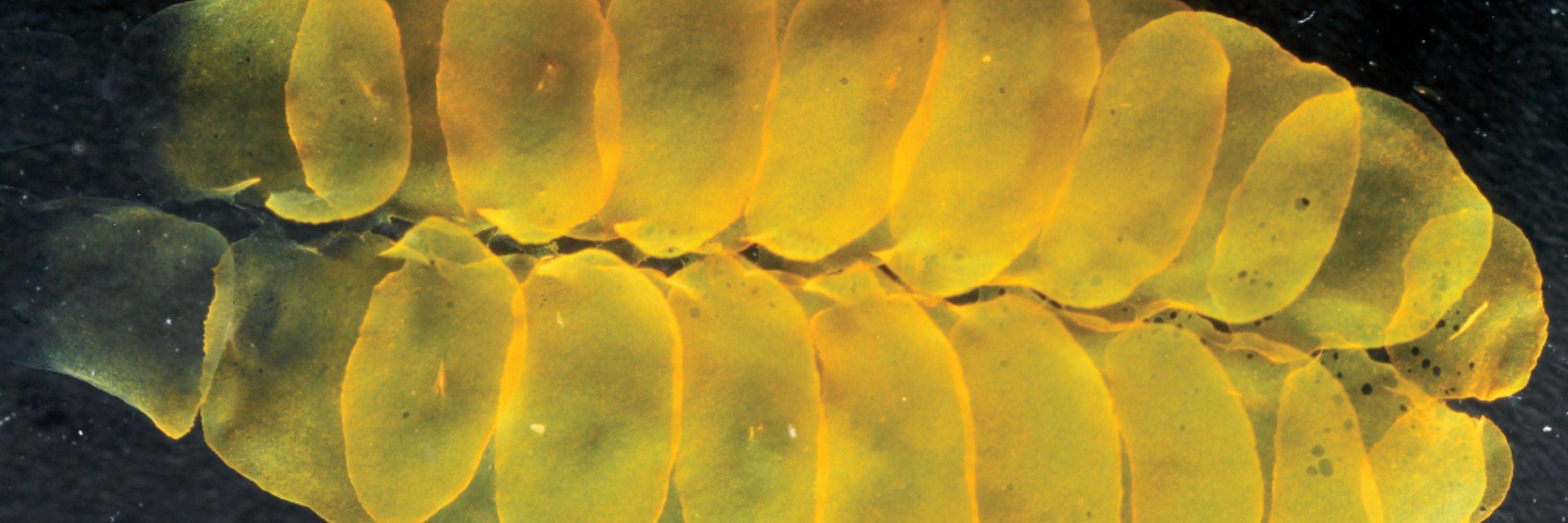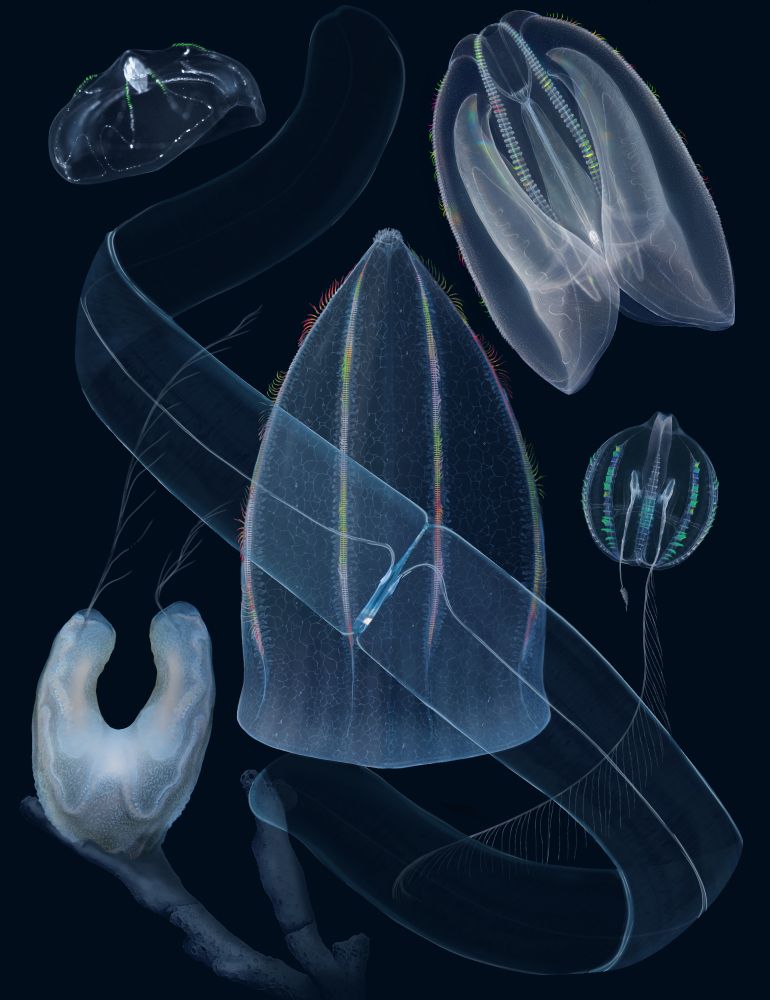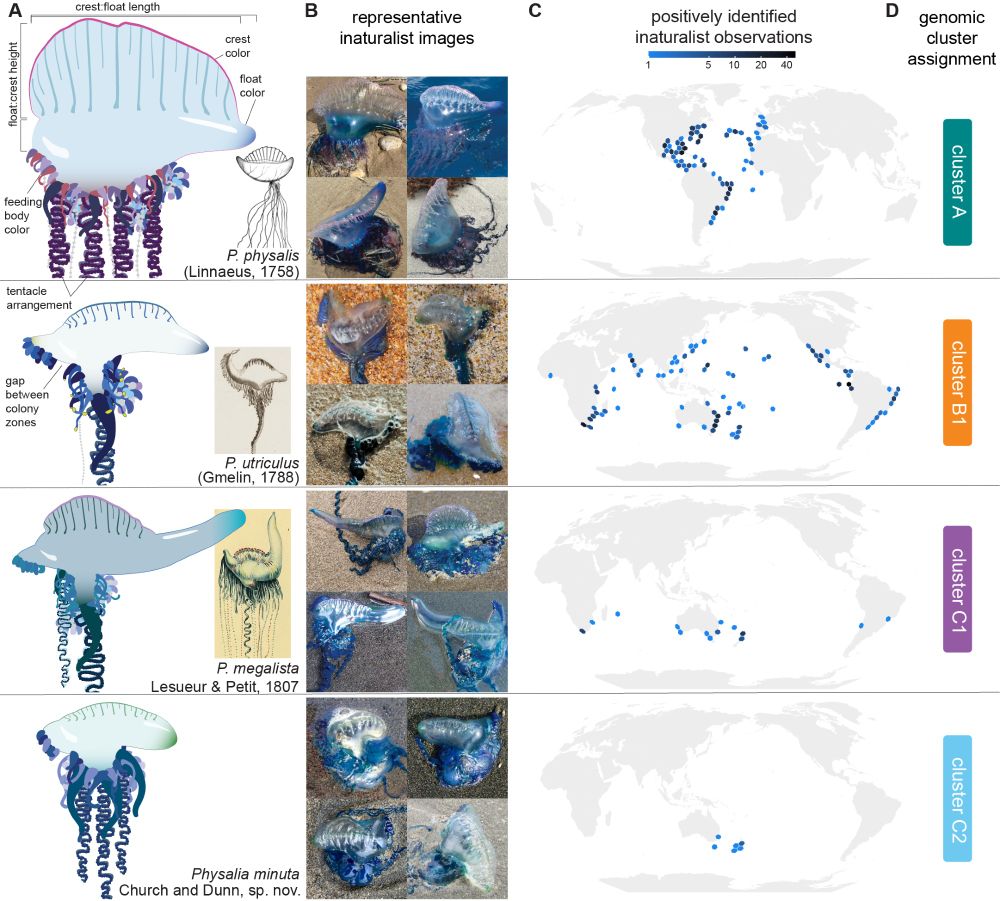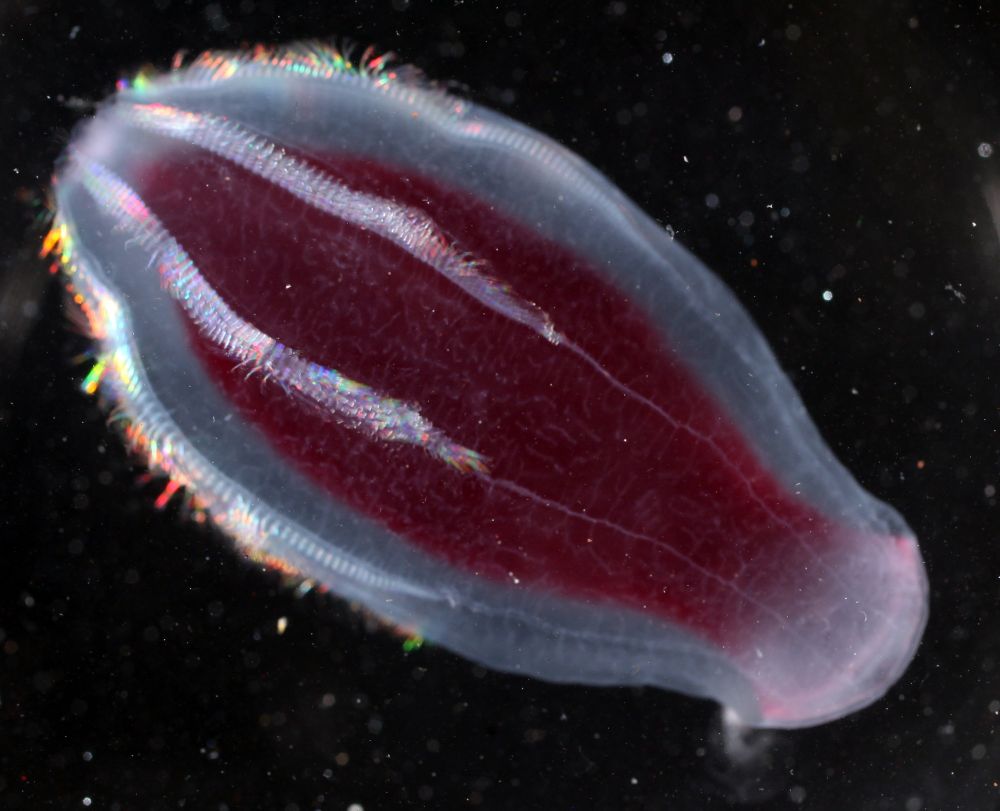
Alejandro Damián-Serrano, Ph.D.
@planktomancer.bsky.social
Friend to the Unseen 🌀💀Comparative naturalist🔬Martial archer🏹Dark fantasy fan🧟♂️AuDHD🧠Amor Fati❤️🔥Valencià🇪🇸
Reposted by Alejandro Damián-Serrano, Ph.D.
The arrow worms are back! Chaetognatha are relatively large carnivorous predators of the plankton (although some are omnivorous) that appear around autumn to feast on smaller zooplankton like copepods! I had lots in my sample this week!
#marineplankton 🦑
#marineplankton 🦑
November 5, 2025 at 8:56 PM
The arrow worms are back! Chaetognatha are relatively large carnivorous predators of the plankton (although some are omnivorous) that appear around autumn to feast on smaller zooplankton like copepods! I had lots in my sample this week!
#marineplankton 🦑
#marineplankton 🦑
Reposted by Alejandro Damián-Serrano, Ph.D.
Researchers are studying how winds, currents, and climate change influence the drift of the Portuguese man o' war in an effort to forecast its seasonal movements.
@ieo.es
@blancobercial.bsky.social
bios.asu.edu/currents/pre...
@ieo.es
@blancobercial.bsky.social
bios.asu.edu/currents/pre...

Predicting the Arrival of the Portuguese Man o' War | BIOS
Scientists are studying how winds, currents, and climate change influence the drift of the Portuguese man o' war in an effort to forecast its seasonal movements
bios.asu.edu
November 5, 2025 at 11:46 PM
Researchers are studying how winds, currents, and climate change influence the drift of the Portuguese man o' war in an effort to forecast its seasonal movements.
@ieo.es
@blancobercial.bsky.social
bios.asu.edu/currents/pre...
@ieo.es
@blancobercial.bsky.social
bios.asu.edu/currents/pre...
Reposted by Alejandro Damián-Serrano, Ph.D.
Some of our favorite covers over the course of the past 11 years have been ones that feature images that beautifully and accurately showcase emerging science.
We might be a bit biased 🫣, but we couldn't agree more @science.org
www.science.org/content/blog...
#ctenophores @msarscentre.bsky.social
We might be a bit biased 🫣, but we couldn't agree more @science.org
www.science.org/content/blog...
#ctenophores @msarscentre.bsky.social

October 27, 2025 at 2:47 PM
Some of our favorite covers over the course of the past 11 years have been ones that feature images that beautifully and accurately showcase emerging science.
We might be a bit biased 🫣, but we couldn't agree more @science.org
www.science.org/content/blog...
#ctenophores @msarscentre.bsky.social
We might be a bit biased 🫣, but we couldn't agree more @science.org
www.science.org/content/blog...
#ctenophores @msarscentre.bsky.social
Reposted by Alejandro Damián-Serrano, Ph.D.
Spooky season royalty 👑🎃✨️
Atolla gigantea is the largest Atolla species found off the West Coast. This deep-sea crown jelly can reach a diameter of up to 15 centimeters (six inches) and is one of the most widely distributed jellyfish. The genus occurs worldwide, from the Arctic to the Antarctic.
Atolla gigantea is the largest Atolla species found off the West Coast. This deep-sea crown jelly can reach a diameter of up to 15 centimeters (six inches) and is one of the most widely distributed jellyfish. The genus occurs worldwide, from the Arctic to the Antarctic.
October 22, 2025 at 4:55 PM
Spooky season royalty 👑🎃✨️
Atolla gigantea is the largest Atolla species found off the West Coast. This deep-sea crown jelly can reach a diameter of up to 15 centimeters (six inches) and is one of the most widely distributed jellyfish. The genus occurs worldwide, from the Arctic to the Antarctic.
Atolla gigantea is the largest Atolla species found off the West Coast. This deep-sea crown jelly can reach a diameter of up to 15 centimeters (six inches) and is one of the most widely distributed jellyfish. The genus occurs worldwide, from the Arctic to the Antarctic.
Reposted by Alejandro Damián-Serrano, Ph.D.
The redhead larvacean is a deep-sea climate hero 🌊💙
These tiny animals build mucous houses to filter marine snow sinking from the waters above. When their filters clog, they abandon their homes, which sink to the seafloor packed with nutrients and large amounts of carbon: youtu.be/7swiAc8rZbk?...
These tiny animals build mucous houses to filter marine snow sinking from the waters above. When their filters clog, they abandon their homes, which sink to the seafloor packed with nutrients and large amounts of carbon: youtu.be/7swiAc8rZbk?...
October 16, 2025 at 8:33 PM
The redhead larvacean is a deep-sea climate hero 🌊💙
These tiny animals build mucous houses to filter marine snow sinking from the waters above. When their filters clog, they abandon their homes, which sink to the seafloor packed with nutrients and large amounts of carbon: youtu.be/7swiAc8rZbk?...
These tiny animals build mucous houses to filter marine snow sinking from the waters above. When their filters clog, they abandon their homes, which sink to the seafloor packed with nutrients and large amounts of carbon: youtu.be/7swiAc8rZbk?...
Reposted by Alejandro Damián-Serrano, Ph.D.
Happy Ctenophore day! Its a perfect day to celebrate such a small yet beautifully diverse phyla that comes in a wide array of shapes and colors. #Ctenophoreday


October 4, 2025 at 1:38 PM
Happy Ctenophore day! Its a perfect day to celebrate such a small yet beautifully diverse phyla that comes in a wide array of shapes and colors. #Ctenophoreday
Reposted by Alejandro Damián-Serrano, Ph.D.
Happy Ctenophore Day!
These glowing ocean drifters look like jellyfish but aren’t! They’re comb jellies, shimmering creatures that light up the sea with rows of beating cilia 💙🌈
Which species can you identify? 👀 Most are raised in @pawelburkhardt.bsky.social lab
#CtenophoreDay #CombJelly #Ctenophore
These glowing ocean drifters look like jellyfish but aren’t! They’re comb jellies, shimmering creatures that light up the sea with rows of beating cilia 💙🌈
Which species can you identify? 👀 Most are raised in @pawelburkhardt.bsky.social lab
#CtenophoreDay #CombJelly #Ctenophore

October 4, 2025 at 6:21 PM
Happy Ctenophore Day!
These glowing ocean drifters look like jellyfish but aren’t! They’re comb jellies, shimmering creatures that light up the sea with rows of beating cilia 💙🌈
Which species can you identify? 👀 Most are raised in @pawelburkhardt.bsky.social lab
#CtenophoreDay #CombJelly #Ctenophore
These glowing ocean drifters look like jellyfish but aren’t! They’re comb jellies, shimmering creatures that light up the sea with rows of beating cilia 💙🌈
Which species can you identify? 👀 Most are raised in @pawelburkhardt.bsky.social lab
#CtenophoreDay #CombJelly #Ctenophore
Reposted by Alejandro Damián-Serrano, Ph.D.
Not uncommon, but always beautiful; the ever flappy-flappy #pelagic #SeaButterfly #Pteropod, Corolla spectabilis. This one is feeding, as can be seen by the mucus net that it’s currently reeling in.
#corollaspectabilis #plankton #blackwater #blackwaterdiving #gug #chrisgug #gugunderwater #ocean
#corollaspectabilis #plankton #blackwater #blackwaterdiving #gug #chrisgug #gugunderwater #ocean
September 10, 2025 at 2:06 PM
Not uncommon, but always beautiful; the ever flappy-flappy #pelagic #SeaButterfly #Pteropod, Corolla spectabilis. This one is feeding, as can be seen by the mucus net that it’s currently reeling in.
#corollaspectabilis #plankton #blackwater #blackwaterdiving #gug #chrisgug #gugunderwater #ocean
#corollaspectabilis #plankton #blackwater #blackwaterdiving #gug #chrisgug #gugunderwater #ocean
Reposted by Alejandro Damián-Serrano, Ph.D.
Our science photo book The Radiant Sea is out Sept 2nd!!
30 years of research, 10 years of "we should", and a year of collating pix and writing.
Sönke and I show (mostly for the first time) images of how organisms produce, use, and interact with light in the sea. #bioluminescence #fluorescence 🦑🧪🌊
30 years of research, 10 years of "we should", and a year of collating pix and writing.
Sönke and I show (mostly for the first time) images of how organisms produce, use, and interact with light in the sea. #bioluminescence #fluorescence 🦑🧪🌊
August 28, 2025 at 2:22 AM
Our science photo book The Radiant Sea is out Sept 2nd!!
30 years of research, 10 years of "we should", and a year of collating pix and writing.
Sönke and I show (mostly for the first time) images of how organisms produce, use, and interact with light in the sea. #bioluminescence #fluorescence 🦑🧪🌊
30 years of research, 10 years of "we should", and a year of collating pix and writing.
Sönke and I show (mostly for the first time) images of how organisms produce, use, and interact with light in the sea. #bioluminescence #fluorescence 🦑🧪🌊
Reposted by Alejandro Damián-Serrano, Ph.D.
Had time to finish another Aliens dive’s memory card from May 6&8, 2024.
1) #Phronima with behbehies in a fantastically-colored salp
2/3) #Siphonophore (don’t lick)
4) #Ctenophore
5) #Swordfish
6) #Polychaete worm
7) #Scaleworm
8) Ctenophore
9) #MantisShrimp
1) #Phronima with behbehies in a fantastically-colored salp
2/3) #Siphonophore (don’t lick)
4) #Ctenophore
5) #Swordfish
6) #Polychaete worm
7) #Scaleworm
8) Ctenophore
9) #MantisShrimp
August 21, 2025 at 4:17 PM
Had time to finish another Aliens dive’s memory card from May 6&8, 2024.
1) #Phronima with behbehies in a fantastically-colored salp
2/3) #Siphonophore (don’t lick)
4) #Ctenophore
5) #Swordfish
6) #Polychaete worm
7) #Scaleworm
8) Ctenophore
9) #MantisShrimp
1) #Phronima with behbehies in a fantastically-colored salp
2/3) #Siphonophore (don’t lick)
4) #Ctenophore
5) #Swordfish
6) #Polychaete worm
7) #Scaleworm
8) Ctenophore
9) #MantisShrimp
Reposted by Alejandro Damián-Serrano, Ph.D.
Marine biodiversity: Gone with the wind? Our dispatch out now in @currentbiology.bsky.social
New research shows that wind and currents act as invisible barriers, reshaping our view of ocean connectivity. 🌊🪼
authors.elsevier.com/a/1lYLj3QW8S...
@iramaegele.bsky.social @msarscentre.bsky.social
New research shows that wind and currents act as invisible barriers, reshaping our view of ocean connectivity. 🌊🪼
authors.elsevier.com/a/1lYLj3QW8S...
@iramaegele.bsky.social @msarscentre.bsky.social

August 4, 2025 at 4:39 PM
Marine biodiversity: Gone with the wind? Our dispatch out now in @currentbiology.bsky.social
New research shows that wind and currents act as invisible barriers, reshaping our view of ocean connectivity. 🌊🪼
authors.elsevier.com/a/1lYLj3QW8S...
@iramaegele.bsky.social @msarscentre.bsky.social
New research shows that wind and currents act as invisible barriers, reshaping our view of ocean connectivity. 🌊🪼
authors.elsevier.com/a/1lYLj3QW8S...
@iramaegele.bsky.social @msarscentre.bsky.social
Reposted by Alejandro Damián-Serrano, Ph.D.
Deep-sea raspberry ❤️✨️
The raspberry jelly (Aeginura grimaldii) is part of a small group of jellies called the narcomedusae. Species in this group are are known for having a relatively small number of tentacles that are attached higher to the bell compared to other groups of jellies.
The raspberry jelly (Aeginura grimaldii) is part of a small group of jellies called the narcomedusae. Species in this group are are known for having a relatively small number of tentacles that are attached higher to the bell compared to other groups of jellies.
August 7, 2025 at 10:36 PM
Deep-sea raspberry ❤️✨️
The raspberry jelly (Aeginura grimaldii) is part of a small group of jellies called the narcomedusae. Species in this group are are known for having a relatively small number of tentacles that are attached higher to the bell compared to other groups of jellies.
The raspberry jelly (Aeginura grimaldii) is part of a small group of jellies called the narcomedusae. Species in this group are are known for having a relatively small number of tentacles that are attached higher to the bell compared to other groups of jellies.
Reposted by Alejandro Damián-Serrano, Ph.D.
Ctenophores possess a unique aboral organ that acts as a multisensory center, controlling complex behaviors. We’ve now created a ctenophore model integrated with our 3D volume EM data. Puts it into perspective.
Check out our recent work here: www.biorxiv.org/content/10.1...
#ctenophores #volumeEM
Check out our recent work here: www.biorxiv.org/content/10.1...
#ctenophores #volumeEM
August 7, 2025 at 8:18 AM
Ctenophores possess a unique aboral organ that acts as a multisensory center, controlling complex behaviors. We’ve now created a ctenophore model integrated with our 3D volume EM data. Puts it into perspective.
Check out our recent work here: www.biorxiv.org/content/10.1...
#ctenophores #volumeEM
Check out our recent work here: www.biorxiv.org/content/10.1...
#ctenophores #volumeEM
Reposted by Alejandro Damián-Serrano, Ph.D.
Adding a little zest to your day with the lemon jelly—Aegina citrea. 🍋
The lemon jelly is different from other jellyfish because it has only four tentacles extending from its bell. Although jellies in the genus Aegina are relatively well known, they can evolve unusual forms or colors in deep water.
The lemon jelly is different from other jellyfish because it has only four tentacles extending from its bell. Although jellies in the genus Aegina are relatively well known, they can evolve unusual forms or colors in deep water.
July 30, 2025 at 9:57 PM
Adding a little zest to your day with the lemon jelly—Aegina citrea. 🍋
The lemon jelly is different from other jellyfish because it has only four tentacles extending from its bell. Although jellies in the genus Aegina are relatively well known, they can evolve unusual forms or colors in deep water.
The lemon jelly is different from other jellyfish because it has only four tentacles extending from its bell. Although jellies in the genus Aegina are relatively well known, they can evolve unusual forms or colors in deep water.
Reposted by Alejandro Damián-Serrano, Ph.D.
My favorite outcome was validating species descriptions from 18th century scientists who illustrated animals on their voyages. Their descriptions were often rejected as implausible – we found that in many cases they were exactly right. Yet another reason why @biodivlibrary.bsky.social is so valuable

June 19, 2025 at 7:51 PM
My favorite outcome was validating species descriptions from 18th century scientists who illustrated animals on their voyages. Their descriptions were often rejected as implausible – we found that in many cases they were exactly right. Yet another reason why @biodivlibrary.bsky.social is so valuable
Reposted by Alejandro Damián-Serrano, Ph.D.
We combined sequencing data with thousands of participatory science images via @inaturalist.bsky.social, to connect genomic clusters to distinct morphologies. Credit to awesome undergraduates River Abedon and Diego Ramirez on this part! www.inaturalist.org/observations...

Portuguese Man o' War (Physalia physalis)
Portuguese Man o' War from Hamilton Parish, Bermuda on April 29, 2022 at 12:59 PM by Miguel A Mejias, PhD.. Native species to the island. Blown in with strong NW winds.
www.inaturalist.org
June 19, 2025 at 7:51 PM
We combined sequencing data with thousands of participatory science images via @inaturalist.bsky.social, to connect genomic clusters to distinct morphologies. Credit to awesome undergraduates River Abedon and Diego Ramirez on this part! www.inaturalist.org/observations...
Reposted by Alejandro Damián-Serrano, Ph.D.
Excited to share our study on sailing siphonophores, AKA bluebottles or man-o'-war! 🌊 we received hundreds of samples from scientists around the world, part of a huge effort to sequence genomes and test for multiple species 🧬 out today in @currentbiology.bsky.social doi.org/10.1016/j.cu... 🦑🧪📌

June 19, 2025 at 7:51 PM
Excited to share our study on sailing siphonophores, AKA bluebottles or man-o'-war! 🌊 we received hundreds of samples from scientists around the world, part of a huge effort to sequence genomes and test for multiple species 🧬 out today in @currentbiology.bsky.social doi.org/10.1016/j.cu... 🦑🧪📌
Reposted by Alejandro Damián-Serrano, Ph.D.
I am used to photographing #ctenophores in darkfield, but under those conditions it is hard to see the pigment spots on this little (5mm) specimen.
Fun to see the patterns that show up when viewed against a white background. 🧪🦑🌊
Fun to see the patterns that show up when viewed against a white background. 🧪🦑🌊

June 11, 2025 at 10:02 PM
I am used to photographing #ctenophores in darkfield, but under those conditions it is hard to see the pigment spots on this little (5mm) specimen.
Fun to see the patterns that show up when viewed against a white background. 🧪🦑🌊
Fun to see the patterns that show up when viewed against a white background. 🧪🦑🌊
Reposted by Alejandro Damián-Serrano, Ph.D.
A rare #Scina #Amphipod, who appears to have caught and is consuming a #ctenophore.
#amphipod #scina #hyperidean #crustacean #blackwater #blackwaterdiving #blackwaterphotography #gug #gugunderwater #chrisgug #underwater #scubadiving
#amphipod #scina #hyperidean #crustacean #blackwater #blackwaterdiving #blackwaterphotography #gug #gugunderwater #chrisgug #underwater #scubadiving

June 6, 2025 at 5:38 PM
A rare #Scina #Amphipod, who appears to have caught and is consuming a #ctenophore.
#amphipod #scina #hyperidean #crustacean #blackwater #blackwaterdiving #blackwaterphotography #gug #gugunderwater #chrisgug #underwater #scubadiving
#amphipod #scina #hyperidean #crustacean #blackwater #blackwaterdiving #blackwaterphotography #gug #gugunderwater #chrisgug #underwater #scubadiving
Reposted by Alejandro Damián-Serrano, Ph.D.
Reposted by Alejandro Damián-Serrano, Ph.D.
#Salps have a solitary and colonial phase in their lives, and the colonies of different species come in a variety of shapes. A new study led by @planktomancer.bsky.social uses videos of salps to examine the swimming of different colony shapes.
Check it out here:
doi.org/10.1242/jeb....
Check it out here:
doi.org/10.1242/jeb....

Colonial architecture modulates the speed and efficiency of multi-jet swimming in salp colonies
Summary: Linear arrangements in multi-jet propelled marine colonial invertebrates are faster than less streamlined architectures without incurring higher costs of transport, offering insights for bioi...
doi.org
June 4, 2025 at 8:55 PM
#Salps have a solitary and colonial phase in their lives, and the colonies of different species come in a variety of shapes. A new study led by @planktomancer.bsky.social uses videos of salps to examine the swimming of different colony shapes.
Check it out here:
doi.org/10.1242/jeb....
Check it out here:
doi.org/10.1242/jeb....
Reposted by Alejandro Damián-Serrano, Ph.D.
Unsolicited listicle: My list of the most criminally underused/underappreciated phylogenetic comparative methods. Note, I am not involved in ANY of these methods; but I see them as things people are often asking of comparative data but have been surprised at how infrequently they have been cited.
May 21, 2025 at 8:06 PM
Unsolicited listicle: My list of the most criminally underused/underappreciated phylogenetic comparative methods. Note, I am not involved in ANY of these methods; but I see them as things people are often asking of comparative data but have been surprised at how infrequently they have been cited.
Reposted by Alejandro Damián-Serrano, Ph.D.
Up close and personal with the angler siphonophore (Erenna sirena). 🎣
This cunning predator dangles luminescent lures that mimic crimson crustaceans and attract unsuspecting fishes. When a curious lanternfish gets too close, the siphonophore’s tentacles deliver a powerful sting and snare a meal.
This cunning predator dangles luminescent lures that mimic crimson crustaceans and attract unsuspecting fishes. When a curious lanternfish gets too close, the siphonophore’s tentacles deliver a powerful sting and snare a meal.
May 14, 2025 at 10:10 PM
Up close and personal with the angler siphonophore (Erenna sirena). 🎣
This cunning predator dangles luminescent lures that mimic crimson crustaceans and attract unsuspecting fishes. When a curious lanternfish gets too close, the siphonophore’s tentacles deliver a powerful sting and snare a meal.
This cunning predator dangles luminescent lures that mimic crimson crustaceans and attract unsuspecting fishes. When a curious lanternfish gets too close, the siphonophore’s tentacles deliver a powerful sting and snare a meal.
Reposted by Alejandro Damián-Serrano, Ph.D.
Meet Eryoneicus, a deep-sea lobster larva. This cutie was spotted at 1,196 meters (3,923 feet) in Monterey Bay. Scientists originally called them Eryoneicus thinking they were a new species, before realizing they were the larval form of deep-sea lobster-like crustaceans in the family Polychelidae.
May 8, 2025 at 8:41 PM
Meet Eryoneicus, a deep-sea lobster larva. This cutie was spotted at 1,196 meters (3,923 feet) in Monterey Bay. Scientists originally called them Eryoneicus thinking they were a new species, before realizing they were the larval form of deep-sea lobster-like crustaceans in the family Polychelidae.
Reposted by Alejandro Damián-Serrano, Ph.D.
Our latest collaborative paper, led by NMNH intern Annemarie Wood, reports on a new tool for understanding ctenophore and medusozoan diversity. "Anthozoan eDNA primer set characterizes Ctenophora and Medusozoa ..." Characterizing #MarineLife
www.frontiersin.org/journals/mar...
www.frontiersin.org/journals/mar...

May 9, 2025 at 1:04 PM
Our latest collaborative paper, led by NMNH intern Annemarie Wood, reports on a new tool for understanding ctenophore and medusozoan diversity. "Anthozoan eDNA primer set characterizes Ctenophora and Medusozoa ..." Characterizing #MarineLife
www.frontiersin.org/journals/mar...
www.frontiersin.org/journals/mar...

